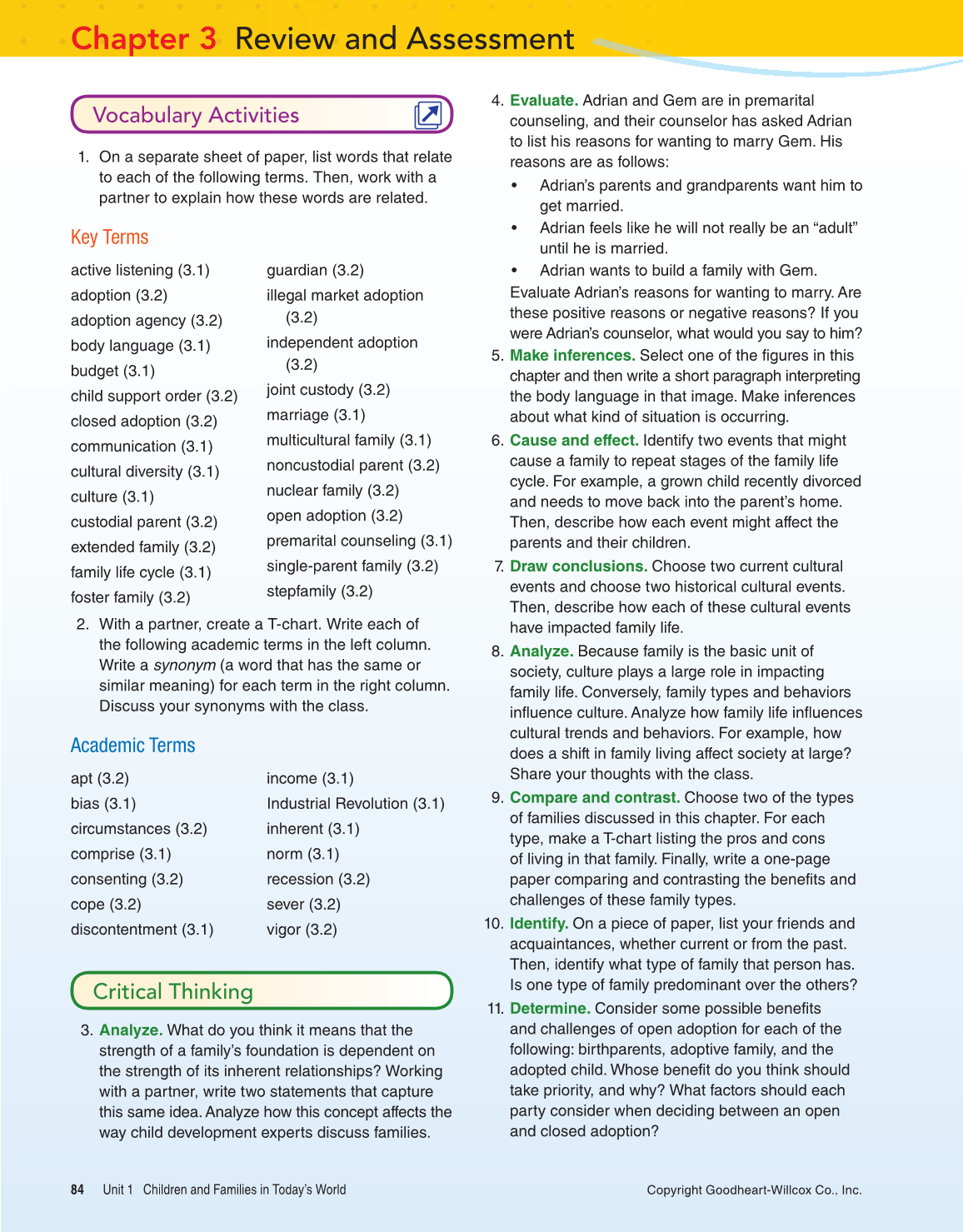84 Unit 1 Children and Families in Today’s World
Copyright Goodheart-Willcox Co., Inc.
Chapter 3 Review and Assessment
Vocabulary Activities
1. On a separate sheet of paper, list words that relate
to each of the following terms. Then, work with a
partner to explain how these words are related.
Key Terms
active listening (3.1)
adoption (3.2)
adoption agency (3.2)
body language (3.1)
budget (3.1)
child support order (3.2)
closed adoption (3.2)
communication (3.1)
cultural diversity (3.1)
culture (3.1)
custodial parent (3.2)
extended family (3.2)
family life cycle (3.1)
foster family (3.2)
guardian (3.2)
illegal market adoption
(3.2)
independent adoption
(3.2)
joint custody (3.2)
marriage (3.1)
multicultural family (3.1)
noncustodial parent (3.2)
nuclear family (3.2)
open adoption (3.2)
premarital counseling (3.1)
single-parent family (3.2)
stepfamily (3.2)
2. With a partner, create a T-chart. Write each of
the following academic terms in the left column.
Write a synonym (a word that has the same or
similar meaning) for each term in the right column.
Discuss your synonyms with the class.
Academic Terms
apt (3.2)
bias (3.1)
circumstances (3.2)
comprise (3.1)
consenting (3.2)
cope (3.2)
discontentment (3.1)
income (3.1)
Industrial Revolution (3.1)
inherent (3.1)
norm (3.1)
recession (3.2)
sever (3.2)
vigor (3.2)
Critical Thinking
3. Analyze. What do you think it means that the
strength of a family’s foundation is dependent on
the strength of its inherent relationships? Working
with a partner, write two statements that capture
this same idea. Analyze how this concept affects the
way child development experts discuss families.
4. Evaluate. Adrian and Gem are in premarital
counseling, and their counselor has asked Adrian
to list his reasons for wanting to marry Gem. His
reasons are as follows:
• Adrian’s parents and grandparents want him to
get married.
• Adrian feels like he will not really be an “adult”
until he is married.
• Adrian wants to build a family with Gem.
Evaluate Adrian’s reasons for wanting to marry. Are
these positive reasons or negative reasons? If you
were Adrian’s counselor, what would you say to him?
5. Make inferences. Select one of the figures in this
chapter and then write a short paragraph interpreting
the body language in that image. Make inferences
about what kind of situation is occurring.
6. Cause and effect. Identify two events that might
cause a family to repeat stages of the family life
cycle. For example, a grown child recently divorced
and needs to move back into the parent’s home.
Then, describe how each event might affect the
parents and their children.
7. Draw conclusions. Choose two current cultural
events and choose two historical cultural events.
Then, describe how each of these cultural events
have impacted family life.
8. Analyze. Because family is the basic unit of
society, culture plays a large role in impacting
family life. Conversely, family types and behaviors
influence culture. Analyze how family life influences
cultural trends and behaviors. For example, how
does a shift in family living affect society at large?
Share your thoughts with the class.
9. Compare and contrast. Choose two of the types
of families discussed in this chapter. For each
type, make a T-chart listing the pros and cons
of living in that family. Finally, write a one-page
paper comparing and contrasting the benefits and
challenges of these family types.
10. Identify. On a piece of paper, list your friends and
acquaintances, whether current or from the past.
Then, identify what type of family that person has.
Is one type of family predominant over the others?
11. Determine. Consider some possible benefits
and challenges of open adoption for each of the
following: birthparents, adoptive family, and the
adopted child. Whose benefit do you think should
take priority, and why? What factors should each
party consider when deciding between an open
and closed adoption?
